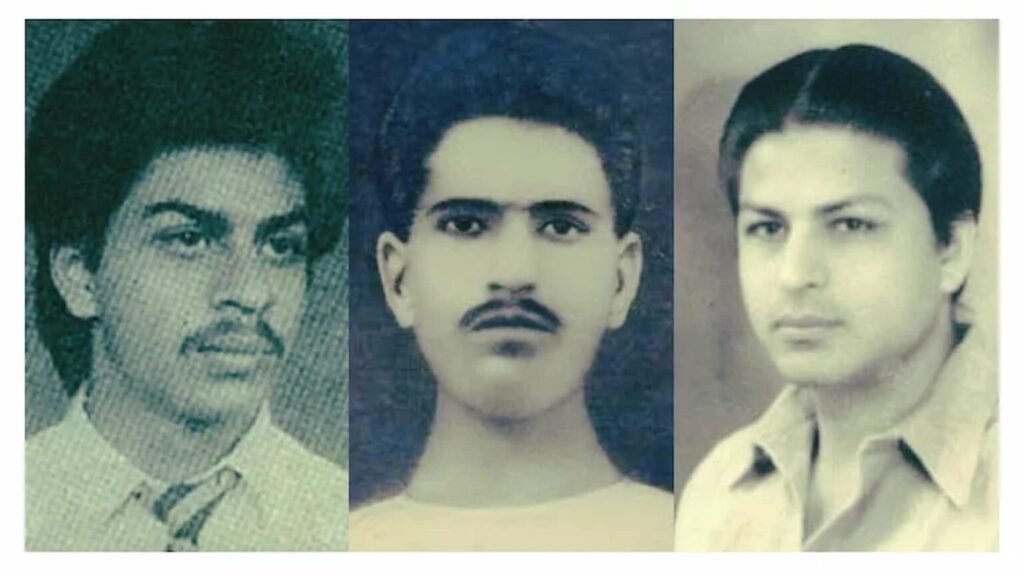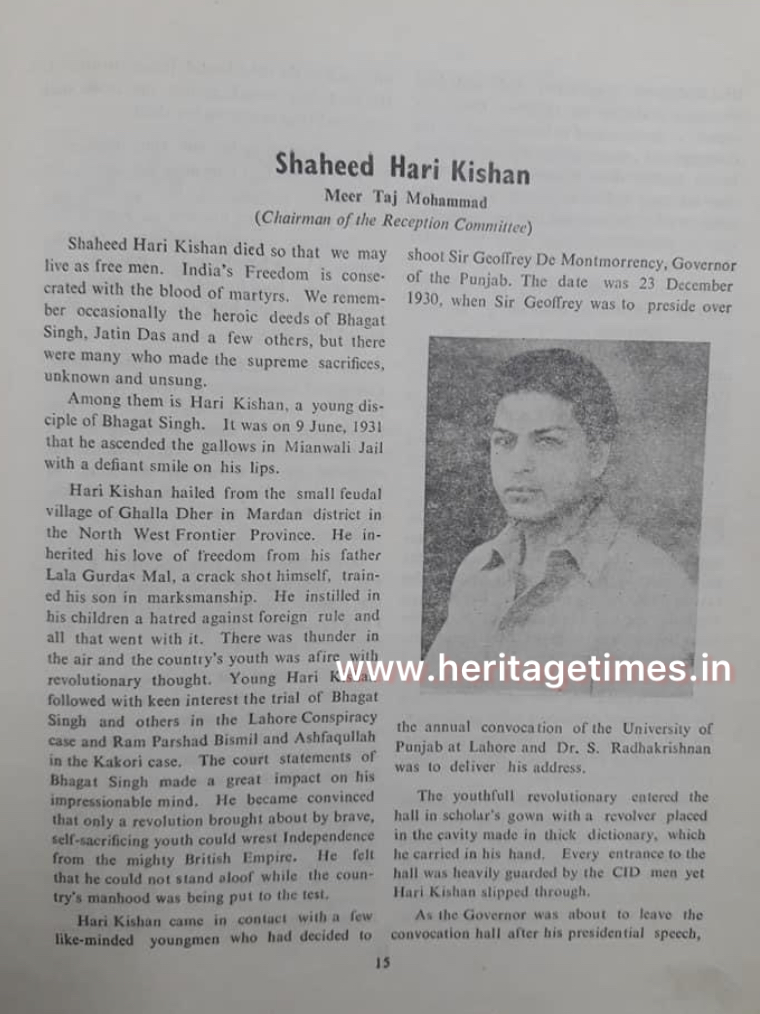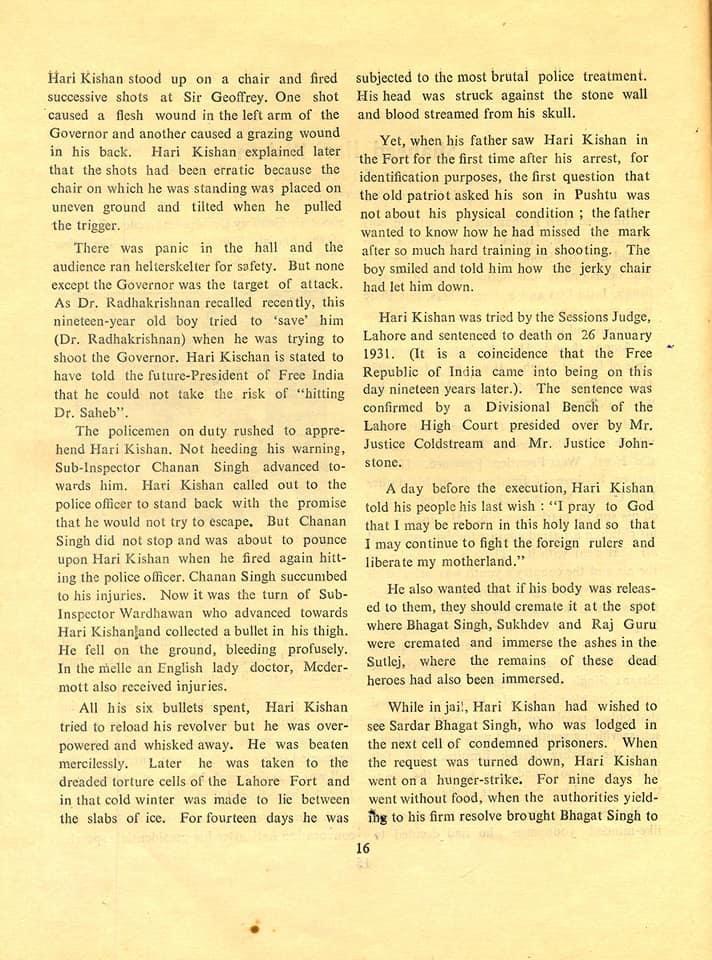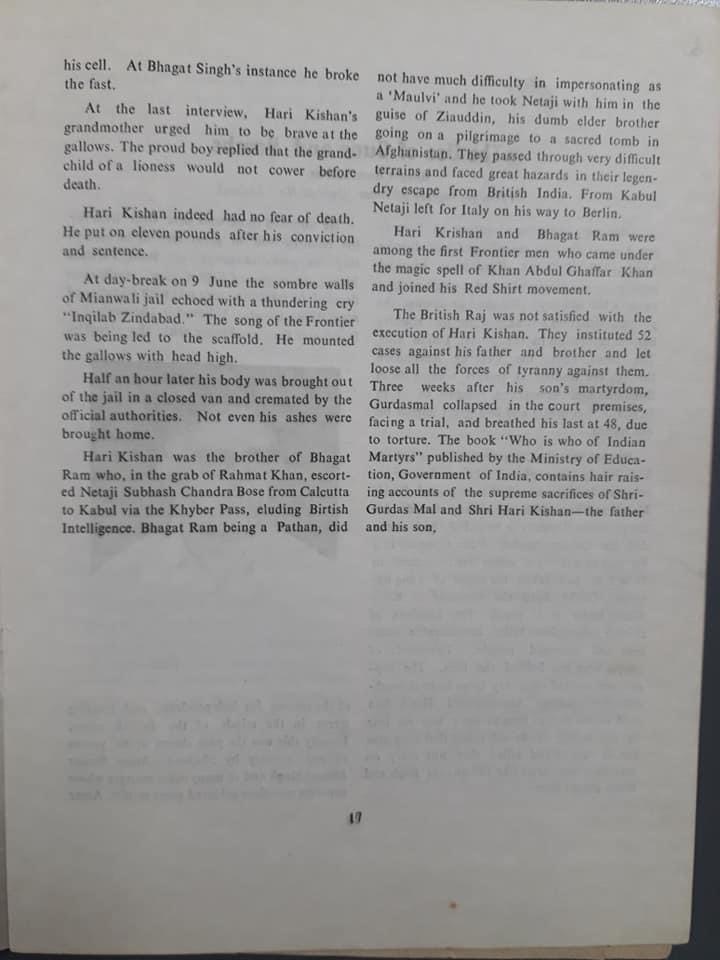INDIA :
Shahrukh Khan’s father Meer Taj Mohammad wrote that Hari Kishan was the brother of Bhagat Ram who, in the grab of Rahmat Khan, escorted Netaji Subhash Chandra Bose from Calcutta to Kabul vin the Khyber Pass, eluding Birtish Intelligence.
Bhagat Ram being a Pathan, did not have much difficulty in impersonating as a ‘Maulvi’ and he took Netaji with him in the guise of Zainuddin, his dumb elder brother going on a pilgrimage to a sacred tomb in Afghanistan.

The article was written by Shahrukh Khan’s father Meer Taj Mohammad, chairman of NWFP Freedom Fighter Association, as a tribute to Hari Kishan Talwar’s martyrdom, whose brother Bhagat Ram Talwar acted as guide to Netaji Subhas Chandra Bose in Afghanistan.
Bhagat Ram also belonged to the same association. Indian film actor Shahrukh Khan is the son of Meer Taj Mohammad.
Shaheed Hari Kishan
Shaheed Hari Kishan died so that we may live as free men. India’s Freedom is consecrated with the blood of martyrs.
We remember occasionally the heroic deeds of Bhagat Singh, Jatin Das and a few others, but there were many who made the supreme sacrifices, unknown and unsung.
Among them is Hari Kishan, a young disciple of Bhagat Singh. It was on 9 June, 1931 that he ascended the gallows in Mianwali Jail with a defiant smile on his lips.
Hari Kishan hailed from the small feudal village of Ghalla Dher in Mardan district in the North West Frontier Province.
He inherited his love of freedom from his father Lala Gurdas Mal, a crack-shot himself, trained his son in marksmanship.
He instilled in his children a hatred against foreign rule and all that went with it.
There was thunder in the air and the country’s youth was afire with revolutionary thought.

Young Hari Kishan followed with keen interest the trial of Bhagat Singh and others in the Lahore Conspiracy case and Ram Parshad Bismil and Ashfaqullah in the Kakori case.
The court statements of Bhagat Singh made a great impact on his impressionable mind.
He became convinced that only a revolution brought about by brave, self-snerificing youth could wrest Independence from the mighty British Empire.
He felt he could not stand aloof while the country’s manhood was being put to the test.
Hari Kishan came in contact with a few like-minded youngmen who had decided to shoot Sir Geoffrey De Montmorrency, Governor of the Punjab.
The date was 23 December 1930, when Sir Geoffrey was to preside over the annual convocation of the University of Punjab at Lahore and Dr. S. Radhakrishnan was to deliver his address.
The youthfull revolutionary entered the hall in scholar’s gown with a revolyer placed in the cavity made in thick dictionary, which carried in his hand.
Every entrance to the that hall was heavily guarded by the CID men yet Har Kishan slipped through.
As the Governor was about to leave the convocation hall after his presidential speech, Hari Kishan stood up on a chair and fired successive shots at Sir Geoffrey.
One shot caused a flesh wound in the left arm of the Governor and another caused a grazing Wound in his back.
Hari Kishan explained later that the shots had been erratic because the chair on which he was standing was placed on uneven ground and tilted when he pulled the trigger.

There was panic in the hall and the audience ran helterskelter for safety. But none except the Governor was the target of attack.
As Dr. Radhakrishnan recalled recently, this nineteen-year old boy tried to save him (Dr. Radhakrishnan) when he was trying to shoot the Governor.
Hari Kishan is stated to have told the future-President of Free India that he could not take the risk of “hitting Dr. Saheb”.
The policemen on duty rushed to appre hend Hari Kishan. Not heeding his warning, Sub-Inspector Chanan Singh advanced to wards him.
Hari Kishan called out to the police officer to stand back with the promise that he would not try to escape. But Chanan Singh did not stop and was about to pounce upon Hari Kishan when he fired again hitting the police officer.
Chanan Singh succumbed to his injuries. Now it was the turn of Sub-Inspector Wardhawan who advanced towards Hari Kishan and collected a bullet in his thigh.
He fell on the ground, bleeding profusely. In the melle an English lady doctor, Mcdermott also received injuries.
All his six bullets spent, Hari Kishan tried to reload his revolver but he was overpowered and whisked away. He was beaten mercilessly.
Later he was taken to the dreaded torture cells of the Lahore Fort and in that cold winter was made to lie between the slabs of ice.
For fourteen days he was subjecled to the most brutal police treatment. His head was struck against the stone wall and blood streamed from his skull.

Yet, when his father saw Hari Kishan in the Fort for the first time after his arrest, for identification purposes, the first question that the old patriot asked his son in Pushtu was not about his physical condition; the father wanted to know how he had missed the mark after so much hard training in shooting.
The boy smiled and told him how the jerky chair had let him down.
Hari Kishan was tried by the Sessions Judge, Lahore and sentenced to death on 26 January 1931. (It is a coincidence that the Free Republic of India came into being on this day nineteen years later.).
The sentence was confirmed by a Divisional Bench of the Lahore High Court presided over by Mr. Justice Coldstream and Mr. Justice Johnstone.
A day before the execution, Hari Kishan told his people his last wish: “I pray to God that I may be reborn in this holy land so that I may continue to fight the foreign rulers and liberate my motherland.”
He also wanted that if his body was released to them, they should cremate it at the spot where Bhagat Singh, Sukhdey and Raj Guru were cremated and immerse the ashes in the Sutlej, where the remains of these dead heroes had also been immersed.
While in jail, Hari Kishan had wished to see Sardar Bhagat Singh, who was lodged in the next cell of condemned prisoners. When the request was turned down, Hari Kishan went on a hunger-strike.
For nine days he went without food, when the authorities yielding to his firm resolve brought Bhagat Singh to his cell. At Bhagat Singh’s instance he broke the fast.
At the last interview, Hari Kishan’s grandmother urged him to be braveat the gallows. The proud boy replied that the grand child of a lioness Would not cower before death.
Hari Kishan indeed had no fear of death. He put on eleven pounds after his conviction and sentence.
At day-break on 9 June the sombre walls of Mianwali jail echoed with a thundering cry “Ingilab Zindabad,” The song of the Frontier was being led to the scaffold, He mounted the gallows with head high.
Half an hour later his body was brought out of the jail in a closed van and cremated by the official authorities. Not even his ashes were brought home.
Hari Kishan was the brother of Bhagat Ram who, in the grab of Rahmat Khan, escorted Netaji Subhash Chandra Bose from Calcutta to Kabul vin the Khyber Pass, eluding Birtish Intelligence.
Bhagat Ram being a Pathan, did not have much difficulty in impersonating as a ‘Maulvi’ and he took Netaji with him in the guise of Zainuddin, his dumb elder brother going on a pilgrimage to a sacred tomb in Afghanistan.
They passed through very difficult terrains and faced great hazards in their legendry escape from British Indin, From Kabul Netaji left for Italy on his way to Berlin.
Hari Krishan and Bhagat Ram were among the first Frontier men who came under the magie spell of Khan Abdul Ghaffar Khan and joined his Red Shirt movement.
The British Raj was not satisfied with the execution of Hari Kishan. They instituted 52 cases against his father and brother and let loose all the forces of tyranny against them.
Three weeks after his son’s martyrdom, Gurdasmal collapsed in the court premises, facing a trial, and breathed his last at 48, due to torture.
The book “Who is who of Indian Martyrs” published by the Ministry of Education, Government of India, contains hair raising accounts of the supreme sacrifices of Shri Gurdas Mal and Shri Hari Kishan – the father and his son.
source: http://www.heritagetimes.in / Heritage Times








